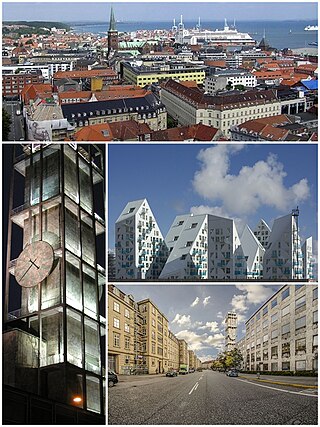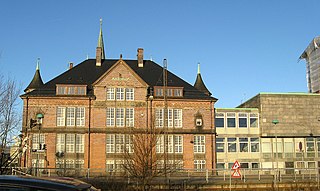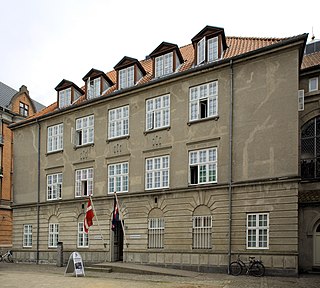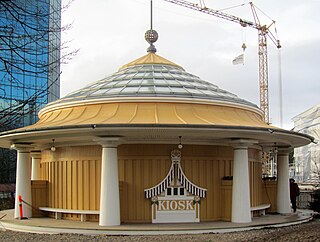
Aarhus is the second-largest city in Denmark and the seat of Aarhus Municipality. It is located on the eastern shore of Jutland in the Kattegat sea and approximately 187 kilometres (116 mi) northwest of Copenhagen.
Higher education in Denmark is offered by a range of universities, university colleges, business academies and specialised institutions. The national higher education system is in accordance with the Bologna Process, with bachelor's degrees, master's degrees and doctoral degrees. The majority of higher education institutions are the responsibility of the Ministry of Higher Education and Science; however, some higher education institutions within the arts are the responsibility of the Ministry of Culture.

Aarhus University is a public research university with its main campus located in Aarhus, Denmark. It is the second largest and second oldest university in Denmark. The university is part of the Coimbra Group, the Guild, and Utrecht Network of European universities and is a member of the European University Association.

Viborg, a city in central Jutland, Denmark, is the capital of both Viborg municipality and Region Midtjylland. Viborg is also the seat of the Western High Court, the High Court for the Jutland peninsula. Viborg Municipality is the second-largest Danish municipality, covering 3.3% of the country's total land area.

Jutland Art Academy, is a state recognized institute for higher education in Aarhus, Denmark, offering a 5-year programme in contemporary art. The academy has no departments and focuses on conceptually driven practices and transdisciplinary work. The academy has about 50 students. The school is located in the street of Mejlgade in the Latin Quarter of Aarhus.
Aarhus University Press is a commercial foundation, founded in 1985 by Aarhus University, Denmark. The main purpose of the press is to publish the scholarly works of researchers at the university, but many authors come from other Danish institutions of higher education and from abroad. The press not only publishes scholarly works, but also disseminates works of intellectual merit and general interest to a broad reader audience. Common to all titles is their strong scholarly base, since all books are peer-reviewed.
VIA University College is a university college organisation in Central Denmark Region, Denmark, established in January 2008. It is present in the region with a total of eight campuses.

The Natural History Museum of Denmark is a natural history museum located in Copenhagen, Denmark. It was created in 2004 through the merger of Copenhagen's Zoological Museum, Geological Museum, Botanical Museum and Central Library, and Botanical Gardens. It is affiliated with the University of Copenhagen. While the Botanical Gardens and the buildings and exhibits of the Geological Museum have been maintained, the old Zoological Museum closed in 2022 and will become part of the new combined Natural History Museum complex in 2025.
The Aarhus University School of Business and Social Sciences is one of four faculties of Aarhus University in Denmark. The school consists of seven departments: Economics and Business Economics, Management, Political Science, Law, Business Communication, Psychology and Behavioural Sciences and Department of Business Development and Technology. The main campus is located in Aarhus.
Harald Mogensen Thamdrup was a Danish biologist and science organizer.

Marselisborg Forests, or simply Marselisborg Forest, is a 550 hectares forest to the south of Aarhus City in the Kingdom of Denmark. Many present day sources now includes the forest of Fløjstrup, as part of the Marselisborg Forests, upping the total area with another 200 hectares. Marselisborg Forests runs along the coastline of the Aarhus Bay in a hilly terrain with steep slopes and deep gullies, especially at the shoreline. There are many traces of prehistoric activities here and the landscape have been covered by woodlands for thousands of years.

Aarhus Katedralskole is a cathedral school, an institution of secondary education, a Danish Gymnasium and a listed building in Aarhus, Denmark. The school is situated in the neighborhood Midtbyen, in the Latin Quarter, bounded by the streets Mejlgade, Kystvejen and Skolegyde. Aarhus Katedralskole offers the 3 year Matriculation examination (STX) programme with elective subjects in the natural sciences, social sciences and arts. The school is an independent self-owning institution financed by the Danish state with about 800 students divided across 30 classes.
Science Museums, Aarhus, founded 1 January 2008, is an umbrella organization comprising the Steno Museum, the greenhouses at Aarhus Botanical Gardens, the Ole Rømer Observatory and a herbarium in Aarhus, Denmark. The Science Museums works as an independent institution under the Science and Technology department of Aarhus University.
The following is a timeline of the history of the city of Aarhus, Central Denmark Region, Denmark.

Risskov Gymnasium is a school of secondary education and a Danish gymnasium in Aarhus, Denmark. The school is a financially independent self-owning educational institution under the Danish state. The school offers the 3 year matriculation examination (STX) programme within four main branches: natural sciences, political sciences, language and art.

Viby Gymnasium is a school of secondary education in the neighborhood Viby J in Aarhus, Denmark. The school offers the 2 year Higher Preparatory Examination (HF) programme, the 3 year Matriculation examination (STX) programme and a vocational programme (EUX).

Aarhus Business College is a business school of secondary education in Aarhus, Denmark. The school offers educational programmes in business and management on a secondary level to post-primary youth, Higher Commercial Examination Programme (HHX) and supplementary courses for adults seeking to maintain qualifications. Last but not least Aarhus Business College has two new types of educations called EUX Business and EUD Business. EUX is an education that combines a 2-year secondary education with a 2-year internship in a company, and EUD is 1 year in school and a 2-year internship in a company. It is an independent self-owned institution under the Danish government, managed by a board composed of members from the business community in conjunction with a rector that oversees day-to-day operations. The school is located on three addresses in Aarhus: Campus Sønderhøj in Viby J and the two campuses of HHX in Risskov and Viby J.

The Occupation Museum in Aarhus, Denmark is a history museum dedicated to present the history of Aarhus during the German occupation in the Second World War. The museum is situated in the historical centre, the Latin Quarter, in Midtbyen and shares the building of the Women's Museum. The building is a listed structure and it is the former city hall and police station of the city, constructed in 1856-57. In the later part of the war it served as the Gestapo headquarters for Jutland after the university buildings - where the Gestapo previously resided - were destroyed during an air raid by the Royal Air Force. The museum is a part of The Old Town in Aarhus, despite not (tilterally) physically being moved there, which is the case with all houses in The Old Town.

The Museum of Ancient Art in Aarhus, Denmark is museum dedicated to the ancient art and cultural history of the mediterranean countries, in particular Ancient Greece, Etruscan civilization and Ancient Rome. The museum is situated in the university campus in the district Midtbyen.

The Danish Poster Museum Danish: Det Danske Plakatmuseum in Aarhus, Denmark is a museum dedicated to the history of poster art. The museum is situated in the open air museum The Old Town in the Town Center neighbourhood in central Aarhus.

















